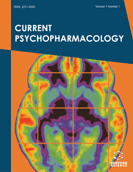Abstract
Etifoxine is an anxiolytic compound structurally unrelated to benzodiazepines and neurosteroids but potentiating GABAA receptor function by a dual mode of action including a direct positive allosteric modulation through a site distinct from that of benzodiazepines. Gabapentin is an antiepileptic drug structurally related to GABA but with a mechanism of action that is still unclear. Methods: Using the four-plate test (FPT) model of anxiety in mice the potential anxiolytic-like effect of gabapentin was first evaluated. In a second part, the effects of both drugs were evaluated in a test retest procedure in the FPT. Results: Gabapentin, for non sedative doses, increased significantly the number of punished passages in the FPT as did etifoxine. In the test -retest procedure, etifoxine (40 and 50 mg.kg) increased the number of shocks accepted by the animal as compared with benzodiazepine. The same effect was observed with gabapentin (32 and 64 mg/kg) with an increase in retested mice responding during the second trial. However, the effect was smaller than that achieved with DOI (a 5-HT2A agonist). Those results are of importance as it was the first time that GABAergic like ligands respond, even weakly, in experienced mice in the FPT. Whether this effect is due to stress or anxiety is open to discussion.
Keywords: Etifoxine, gabapentin, four-plate test, test-retest procedure, stress, anxiety, mice, benzodiazepine, Xenopus oocytes, GABAAR, neocortex, hypothalamus, diazepam, Flumazenil
Current Psychopharmacology
Title: Insight into the Mechanism of the Four-Plate Test-Retest Procedure Using Etifoxine as Compared with Gabapentin
Volume: 1
Author(s): Michel Bourin and Martine Hascoet
Affiliation:
Keywords: Etifoxine, gabapentin, four-plate test, test-retest procedure, stress, anxiety, mice, benzodiazepine, Xenopus oocytes, GABAAR, neocortex, hypothalamus, diazepam, Flumazenil
Abstract: Etifoxine is an anxiolytic compound structurally unrelated to benzodiazepines and neurosteroids but potentiating GABAA receptor function by a dual mode of action including a direct positive allosteric modulation through a site distinct from that of benzodiazepines. Gabapentin is an antiepileptic drug structurally related to GABA but with a mechanism of action that is still unclear. Methods: Using the four-plate test (FPT) model of anxiety in mice the potential anxiolytic-like effect of gabapentin was first evaluated. In a second part, the effects of both drugs were evaluated in a test retest procedure in the FPT. Results: Gabapentin, for non sedative doses, increased significantly the number of punished passages in the FPT as did etifoxine. In the test -retest procedure, etifoxine (40 and 50 mg.kg) increased the number of shocks accepted by the animal as compared with benzodiazepine. The same effect was observed with gabapentin (32 and 64 mg/kg) with an increase in retested mice responding during the second trial. However, the effect was smaller than that achieved with DOI (a 5-HT2A agonist). Those results are of importance as it was the first time that GABAergic like ligands respond, even weakly, in experienced mice in the FPT. Whether this effect is due to stress or anxiety is open to discussion.
Export Options
About this article
Cite this article as:
Bourin Michel and Hascoet Martine, Insight into the Mechanism of the Four-Plate Test-Retest Procedure Using Etifoxine as Compared with Gabapentin, Current Psychopharmacology 2012; 1 (1) . https://dx.doi.org/10.2174/2211556011201010002
| DOI https://dx.doi.org/10.2174/2211556011201010002 |
Print ISSN 2211-5560 |
| Publisher Name Bentham Science Publisher |
Online ISSN 2211-5579 |
 15
15
- Author Guidelines
- Bentham Author Support Services (BASS)
- Graphical Abstracts
- Fabricating and Stating False Information
- Research Misconduct
- Post Publication Discussions and Corrections
- Publishing Ethics and Rectitude
- Increase Visibility of Your Article
- Archiving Policies
- Peer Review Workflow
- Order Your Article Before Print
- Promote Your Article
- Manuscript Transfer Facility
- Editorial Policies
- Allegations from Whistleblowers
- Announcements
Related Articles
-
Cancer Diagnosis and Treatment Guidance: Role of MRI and MRI Probes in the Era of Molecular Imaging
Current Pharmaceutical Biotechnology Glutamate Carboxypeptidase II in Diagnosis and Treatment of Neurologic Disorders and Prostate Cancer
Current Medicinal Chemistry Aligning Animal Models of Clinical Germinal Matrix Hemorrhage, From Basic Correlation to Therapeutic Approach
Current Drug Targets 5-HT7 Receptor Ligands: Recent Developments and Potential Therapeutic Applications
Mini-Reviews in Medicinal Chemistry Zebrafish as an Animal Model to Study Epileptic Seizures and Epileptic Syndromes
Current Psychopharmacology Voltage-Gated Sodium Channels: Mutations, Channelopathies and Targets
Current Medicinal Chemistry Prevalence of Anti-nuclear and Anti-phospholipid Antibodies in an Egyptian Cohort with Schizophrenia: A Case-control Study
Current Rheumatology Reviews A Review on Hematopoietic Stem Cell Treatment for Epilepsy
CNS & Neurological Disorders - Drug Targets Targeting Ionotropic Glutamate Receptors in the Treatment of Epilepsy
Current Neuropharmacology Metabotropic Glutamate Receptors in Central Nervous System Diseases
Current Drug Targets ERRATUM 1
Current Neuropharmacology Are Carbonic Anhydrase Inhibitors Suitable for Obtaining Antiobesity Drugs ?
Current Pharmaceutical Design Curcumin Reduces Neuronal Loss and Inhibits the NLRP3 Inflammasome Activation in an Epileptic Rat Model
Current Neurovascular Research Non-adenosine Nucleoside Inosine, Guanosine and Uridine as Promising Antiepileptic Drugs: a Summary of Current Literature
Mini-Reviews in Medicinal Chemistry Association and Causal Relationship of Midlife Obesity and Related Metabolic Disorders with Old Age Cognition
Current Alzheimer Research Parallel Computing for Brain Simulation
Current Topics in Medicinal Chemistry Review of the Phytochemistry and Biological Activity of Cissus incisa Leaves
Current Topics in Medicinal Chemistry Targeting Striatal Metabotropic Glutamate Receptor Type 5 in Parkinson’s Disease: Bridging Molecular Studies and Clinical Trials
CNS & Neurological Disorders - Drug Targets Cannabidiol Partially Blocks the Excessive Sleepiness in Hypocretindeficient Rats: Preliminary Data
CNS & Neurological Disorders - Drug Targets Metabotropic Glutamate Receptors Modulate Periaqueductal Grey Descending Analgesic System
Central Nervous System Agents in Medicinal Chemistry


























